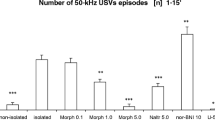Abstract
The present study demonstrates that low doses of promethazine (1.25–5 mg/kg SC) dose-dependently facilitate nociception in the vocalization test in rats. However, this effect disappeared gradually with increasing dose, and in contrast, high doses (20–40 mg/kg SC) induced an antinociceptive effect. This indicates that promethazine, depending upon the biophase concentration, has the potential to interact with separate antagonizing or opposing functional systems, producing contrasting effects on nociception. The sigmoid E max model was fitted to the observed composite effect, and dose-response characteristics for two opposite effects were described. In addition, when suprathreshold stimulation was used to evoke nociception, the stimulus amplified the hyperalgesic efficacy of promethazine but left the potency of this effect unaltered. In this experimental situation only negligible antinociception was observed. Our data thus show that for promethazine, the net effect on nociception in rats is not absolute but is balanced both by the biophase concentration and by the effectiveness of the stimulation used to evoke nociception.
Similar content being viewed by others
References
Aronson CE, Hanno ERS (1979) Effect of promethazine on the isolated perfused rat heart. Gen Pharmacol 10:389–395
Bluhm R, Zsigmond EK, Winnie AP (1982) Potentiation of opioid analgesia by H1 and H2 antagonists. Life Sci 31:1229–1232
Buchsbaum MS, Davis GC, Naber D, Picker D (1983) Pain enhances naloxone-induced hyperalgesia in humans as assessed by somatosensory evoked potentials. Psychopharmacology 79:99–103
Carroll MN, Lim RKS (1960) Observations on the neuropharmacology of morphine and morphine like analgesia. Arch Int Pharmacodyn Ther 125:383–403
Conner JT, Bellville JW, Wender R, Wapner S, Dorey FJ, Katz RL (1977) Morphine and promethazine as intravenous premedicants. Anesth Analg 56:801–807
Di Chiara G, Corsini GU, Mereu GP, Tissari A, Gessa GL (1978) Self-inhibitory dopamine receptors: their role in the biochemical and behavioral effects of low doses of apomorphine. In: Roberts PJ (ed) Advances in biochemical psychopharmacology. Raven Press, New York, pp 275–292
Douglas WW (1980) Histamine and 5-Hydroxytryptamine and their antagonists. In: Goodman and Gilman (eds) The pharmacological basis of therapeutics. Macmillan Publishing Inc, New York, pp 622–629
Finch L, Haeusler G (1973) The cardiovascular effects of apomorphine in the anaesthetized rat. Eur J Pharmacol 21:264–270
Freedman GL, Allen GD (1969) Comparison of differing modalities of experimental pain in man. J Dent Res 49:378–380
Holford NHG, Sheiner LB (1981) Understanding the dose-effect relationship: Clinical application of pharmacokinetic-pharmacodynamic models. Clin Pharmacokinet 6:429–453
Hopkin BDA, Hurter D, Jones CM (1957) Promethazine and pethidine in anaesthesia. Anaesthesia 12:276–281
Kaplan R, Glick SD (1979) Prior exposure to footshock induced naloxone hyperalgesia. Life Sci 24:2309–2312
Keats AS, Telford J, Kurosu Y (1960) “Potentiation” of meperidine by promethazine. Anesthesiology 22:34–41
Kopera J, Armitage AK (1954) Comparison of some pharmacological properties of chlorpromazine, promethazine and pethidine. Br J Pharmacol 9:392–401
Leak D, Carroll D (1967) Promethazine poisoning: Clinical and electroencephalographic observations. Br Med J 2:31–32
Léslie GB, Nunn B (1968) The effect of promethazine on the antinociceptive actions of some narcotic analgesics. J Pharm Pharmacol 20:881–882
Lineberry CG (1981) Laboratory animals in pain research. In: Gay W (ed) Methods in animal experimentation. Academic Press Inc, London New York 6:256–262
McQuitty FM (1967) Relief of pain in labour. J Obstet Gynaecol Br Cwlth 74:925–928
Moore J, Dundee JW (1961a) Alterations in response to somatic pain associated with anaesthesia. V: The effect of promethazine. Br J Anaesth 33:3–8
Moore J, Dundee JW (1961b) Alterations in response to somatic pain associated with anaesthesia. VII: The effects of nine phenothiazine derivatives. Br J Anesth 33:422–432
Paalzow G, Paalzow L (1973) The effects of caffeine and theophylline on nociceptive stimulation in the rat. Acta Pharmacol Toxicol 32:22–32
Paalzow GHM, Paalzow LK (1982) Separate noradrenergic receptors could mediate clonidine-induced antinociception. J Pharmacol Exp Ther 223:795–800
Paalzow GHM, Paalzow LK (1983a) Opposing effects of apomorphine on pain in rats. Evaluation of the dose-response curve. Eur J Pharmacol 88:27–35
Paalzow GHM, Paalzow LK (1983b) Yohimbine both increases and decreases nociceptive thresholds in rats: evaluation of the dose-response relationship. Naunyn-Schmiedeberg's Arch Pharmacol 322:193–197
Samuels AS (1957) Phenergan in treatment of psychiatric patients. Dis Nerv Syst 18:183–188
Seeman P, Staiman A, Chau-Wong M (1974) The nerve impulse-blocking actions of tranquilizers and the binding of neuroleptics to synaptosome membranes. J Pharmacol Exp Ther 190:123–130
Shea JG, Schultz JD, Lewis E, Fazekas JF (1958) The clinical and cerebral action of promethazine and methylphenidate hydrochloride. Am J Med Sci 235:201–205
Siker ES, Wolfson B, Stewart WD, Schaner PJ (1966) The earlobe algesimeter. 2. The effect on pain threshold of certain phenothiazine derivatives alone or combined with merperidine. Anesthesiology 27:497–500
Sokal RR, Rohlf FJ (1969) Biometry. WH Freeman and Comp. San Francisco
Terman GW, Lewis JW, Liebeskind JC (1982) Role of the biogenic amines in stress analgesia. Proc West Pharmacol Soc 25:7–10
Weller CP, Ibrahim I, Sulman FG (1968) Analgesic profile of tranquillizers in multiple screening tests in mice. Arch Int Pharmacodyn Ther 176:176–190
Author information
Authors and Affiliations
Additional information
The ethical guidelines of the Committee for Research and Ethical Issues of the IASP have been considered in the present investigation (Pain 16:109–110, 1983)
Rights and permissions
About this article
Cite this article
Paalzow, G.H.M., Paalzow, L.K. Promethazine both facilitates and inhibits nociception in rats: Effect of the testing procedure. Psychopharmacology 85, 31–36 (1985). https://doi.org/10.1007/BF00427318
Received:
Accepted:
Issue Date:
DOI: https://doi.org/10.1007/BF00427318




